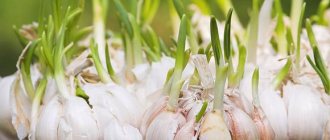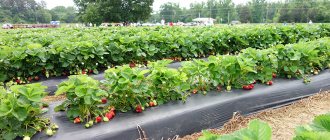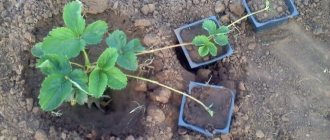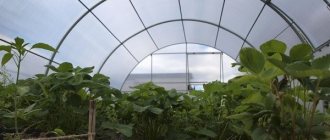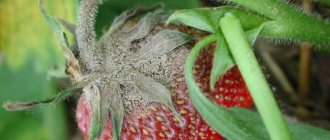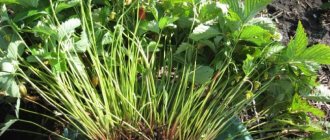04/24/2019 Michur Ivanov Garden and vegetable garden Nowadays, strawberries are present on store shelves all year round. But, of course, the most delicious is the one grown in your own garden. Often, berry lovers think about a strawberry business. And here they are faced with many questions. One of them: how many strawberries can you harvest from 1 hundred square meters? This and many other questions will be answered in the article.
Growing methods
First of all, you need to decide how exactly to cultivate the berries: in open ground or in a greenhouse.
The main disadvantage of growing outdoors is that precious crops will be lost due to unfavorable weather conditions.
Strawberries under a film coating are reliably protected from all negative factors, which allows you to increase the yield by 25% compared to open-air cultivation.
In addition, strawberries from a greenhouse are more transportable and can be stored longer. This way you can grow berries for several years. Thus, if the question is about obtaining a high yield, you should prefer a greenhouse.
Time-tested varieties
They have been successfully grown for many years in a greenhouse and consistently produce a rich, high-quality harvest. Each has its own characteristics, which must be taken into account before planting.
Evie 2
Remontant high-yielding variety with large sweet berries. The variety is intended for protected ground. The main advantage is that the culture tolerates transportation well. If agrotechnical standards are met, about 2 kg of crop is harvested from each Evi bush.
Honey
Can be grown in open ground. The variety is highly resistant to one of the biggest scourges for all varieties kept indoors - gray rot. The culture is not afraid of temporary increases in humidity and decreases in temperature, and does not deteriorate during transportation. The fruiting of the variety is not the highest. From a bush you get about 500 g of sweet and sour berries.
Alba
An early ripening variety with tasty conical berries. Like most varieties grown in protected ground, it tolerates transportation well. It can be kept in unfavorable conditions for a long time, but it yields 1.2 kg from each bush only if all cultivation rules are followed.
Elsanta
On average, it produces about 1.5 kg of medium berries from each bush. It has excellent taste, but is demanding to care for. These strawberries can only be kept in a heated greenhouse, since they may die during frost. With the exception of low temperatures, the variety almost never gets sick and is not affected by pests.
Octave
Fruits well in closed ground conditions. The berries have a wonderful aroma and excellent taste characteristics. The early-ripening variety tolerates low temperatures well, so a short absence of heating will not lead to the death of the bush, and it is also resistant to many pests.
Sonata
Dutch variety with large aromatic dessert berries. Excellent resistance to powdery mildew and gray rot. Has proven itself well in greenhouse conditions.
Darenka
A non-repairing, early-ripening variety, bred by Russian breeders for planting in protected soil. The culture is resistant to almost all diseases. Sweet berries with a characteristic strawberry taste ripen on the bushes.
Possible options
Traditionally, strawberries are grown in greenhouses. In such premises it is possible to achieve a greenhouse effect, which has a beneficial effect on plant growth and fruit ripening. The Dutch growing technology is especially popular, which involves planting seedlings in plastic bags. This method is ideal for a greenhouse. How many strawberries can be harvested from 1 acre in this case? Experts call the figure 225-250 kg, which is fair for beginning farmers.
There are many technologies for growing strawberries in a greenhouse, and you can choose the one that suits you. The least labor-intensive, but at the same time expensive, is the use of hydroponics. It is much more economical to grow in plastic bags with soil. Moreover, favorable conditions for growth and fruiting can be created in winter. All technologies for year-round cultivation of strawberries are based on this feature.
Advantages of growing strawberries as a business:
- In a heated room, crops can be harvested all year round. At the same time, fruiting and quality of berries do not depend on weather conditions. In open ground, productivity decreases by 25%.
- The initial costs of the business pay off quite quickly - within a season.
- The high price of berries in winter allows you to make a good profit.
- In greenhouse conditions, caring for plantings is much easier than in open ground.
- Such a business is highly profitable - 100%.
Of course, there are also disadvantages:
- Large costs at the very beginning of a business.
- The need to pay salaries to employees. You won’t be able to cope with all the troubles on your own.
- Heating organization. Without this important nuance, it is impossible to grow strawberries all year round.
Advantages and disadvantages of cultivating strawberries under artificial conditions
And I would like to start with the advantages:
- Is it profitable to grow strawberries for sale? Without a doubt - yes. Fresh strawberries are in all-season demand. Among its customers: bars and restaurants;
- the shops;
- food stores and resellers;
- food industry enterprises;
- individuals – retail buyers.
In addition, in the autumn months, its retail price jumps sharply (at least 2 times).
- The correct choice of technology for growing strawberries allows you to make the most of the available land at your summer cottage to generate a stable income (this is business).
- The productivity of this crop allows you to earn decent money even on relatively small land areas.
- No special soil or fertilizers are required for planting bushes.
- Bushes can be planted in ordinary flower pots, hanging them on horizontal bars in 3 tiers in a checkerboard pattern (in a vertical plane) and leaving between the rows a space for a passage 1 row wide. This will make soil replacement, harvesting and regular watering more ergonomic. Thus, out of a total area of 200 m², only 67% will be useful, and 33% will be spent on walkways. But vertically it turns out that the bushes are planted in 3 rows.
- Strawberries are resistant to diseases (and in the case of the technology under consideration, they do not come into contact with the soil at all, that is, contact with pests is also excluded).
- Modern strawberry varieties are self-pollinating - you don’t have to worry about insects, etc.
- Proper control of the light flux allows for continuous fruiting. However, to be able to calculate numerical indicators, we will assume that 5 harvests can be collected in a year (after which it will be necessary to replace the soil in the pot and replant the bush).
- A vital watering system is created extremely simply: a hose is stretched from pot to pot, and holes are pierced through it, through which moisture flows directly to the roots of the plants. This is an economically and biologically extremely effective irrigation method that does not require the installation of additional control systems.
There are also disadvantages:
- Mushrooms can be grown in 3-4 tiers - they do not need as much light as strawberries require. And you have to be honest with yourself: no matter what the famous “Dutch method” promises (that by planting in 5-6 tiers, up to 50 bushes can be grown per 1 m² of greenhouse), you should understand that more than 16-18 bushes per 1 m² will simply not be planted. If this indicator is exceeded, the bushes will simply begin to shade each other. In addition, processing a 3-tier or more-tier greenhouse is becoming extremely inconvenient and low-tech.
- High capital investments for the construction of a greenhouse at the very first stage of business (at least 1 million rubles will be spent on the greenhouse alone).
- Even taking into account that the greenhouse will be made of sealed double-glazed windows, at least 10 kW of electrical power will still be required to heat a 200-meter area with a ceiling height of 3.5 meters. (Not everyone in their summer cottages has such a technical capability).
Greenhouse options
There are several types of greenhouses. They differ in design, materials and heating system. When choosing a material, climate, budget, and cultivation method are taken into account.
When creating a greenhouse, we focus on the following plan:
- They are constructing a building.
- They make heating.
- Purchase gardening equipment.
- Organize an irrigation system.
- Fill the greenhouse with soil.
- They purchase fertilizers and preparations to protect plantings from parasites and diseases.
- Buy planting material.
Greenhouse material
When choosing a material, you should understand that it must have sufficient strength, provide good thermal insulation, and be suitable for weather conditions.
Among the variety of materials, three main ones should be highlighted:
- Film. The most economical, but also less reliable option. The film is not suitable for winter. It quickly begins to tear, becomes cloudy and is not able to retain heat well. For a year-round strawberry growing business, this is the worst option. The film is suitable only for regions with warm and little snowy winters.
- Glass. This material is more reliable than film. When erecting a glass greenhouse, first build a foundation. Glass is placed in frames. Glass is a fragile material, it can be destroyed by hail, break under the weight of snow, and crack when temperature changes. However, maintaining the desired microclimate in glass greenhouses is easier than in film greenhouses.
- Polycarbonate. It is cheaper than glass, reliable, able to withstand heavy loads, and is not afraid of gusty winds. The greenhouse is most stable if the polycarbonate is attached to a metal frame securely dug into the ground. Carbonate is durable, light and elastic, easy to wash. For such greenhouses there is no need for a foundation. They can last 10-20 years.
Selection of strawberry seedlings and care rules
Beginning farmers are advised to buy strawberry seedlings from nurseries, agricultural shows and fairs. Before planting, the seedlings need to be kept for some time in the basement or refrigerator; the plants will be dormant. Plants are purchased for agricultural business in early autumn. Experienced farmers can grow seedlings themselves, sowing purchased seeds or their own from previous strawberry harvests.
For the strawberry business, varieties of berries that do not require pollination and remontant bushes are suitable. Such plants will be able to bear fruit all year round. You should not give preference to one variety of strawberry; it is better to choose several early and late varieties with large red berries and a rich aroma.
The most popular varieties of strawberries for cultivation in a greenhouse: Alba, Rusanovskaya, Talisman, Honey, Redgauntlet, Zenga Zengana, Darenka, Octave, Sonata. With the cost of one seedling being 50 rubles, purchasing strawberry seedlings for one year for a greenhouse with an area of 100 m2 will require 15-20 thousand rubles.
The substrate for strawberries consists of perlite sand and peat.
Plastic bags are filled with earthen mixture, and several cuts are made in the bag, into which strawberry bushes are planted. You can also use plastic pots instead of bags in a greenhouse for strawberries. The cost of 1 m3 of peat is 450 rubles, perlite is 1000 rubles. The purchase of land for a greenhouse will cost about 15-20 thousand rubles .
An important aspect of a successful strawberry growing business is maintaining the humidity level in the greenhouse at least 80%, applying fertilizers 2 times a month, regular ventilation, and bright lighting all year round.
Which containers do you prefer?
To grow strawberries in a greenhouse, you will need containers filled with nutritious soil, where the plants will be planted. For this purpose you can take:
- pots;
- packages;
- bags.
There should be holes at the bottom of the containers so that water can escape. Metal vessels are not recommended - this material is too cold and is not at all suitable for growing berries.
Containers are placed on racks with durable slats. Wooden shelves can become deformed when exposed to moisture; the wood must be pre-coated with waterproof varnish.
Business income and expenses
To assess the return on investment of a business, you need to calculate the approximate revenue from sales of strawberries.
The yield from 1 m2 of plantings in a greenhouse is 20 kg. In just one revolution you can get up to 2000 kg of strawberries. With an average selling price of strawberries of 400 rubles per 1 kg, revenue will be 800 thousand rubles.
The largest cost item for a business will be utility bills for light and water, which are needed all year round. Investments annually will amount to about 100 thousand rubles. The total business costs for building a greenhouse, purchasing seedlings and soil mixture will be 185 thousand rubles . Thus, investments in the business of growing strawberries in a greenhouse will pay off in 6-8 months, depending on the yield.
Like any other type of business, growing strawberries has its advantages and limitations. With low costs for the construction of a greenhouse, the first return can be obtained within six months. Subsequent business expansion and establishment of sales channels will provide high, stable income.
Heating, watering and lighting
In the greenhouse you need to maintain:
- Temperature.
- Humidity.
- Lighting.
Nowadays, farmers most often prefer heating with electricity. The temperature is adjusted automatically. If strawberries grow on the ground, the most intense heating mode is necessary. If the plants are in containers, the temperature may be lower.
Humidity is maintained by regular watering. Drip irrigation is very convenient and therefore popular. This way the plants can be provided with the right amount of moisture. To control the parameter, a hygrograph or psychrometer is used.
Lighting is necessary to extend daylight hours in a greenhouse. Fluorescent lamps are usually installed.
In modern greenhouses, automation controls environmental parameters. Special sensors monitor temperature, humidity and lighting. Of course, such systems are expensive, so at the beginning of a business it makes sense to use more modest systems.
When choosing the material and method of heating the greenhouse, the climate of the region is taken into account. In the southern regions, you can install thermos greenhouses, which are heated by solar heat and ventilated. In Siberia and similar cold regions, infrared heating and pumps are often used, thanks to which they can retain heat in the most severe winters. In areas with a temperate climate, biofuel is suitable for heating, as it releases heat when decomposed.
In addition to all of the above, when creating a greenhouse you will also need:
- lamps;
- drip irrigation system;
- various heating devices: boilers, potbelly stoves, etc.;
- fans;
- hygrometers and thermometers;
- reflectors.
Strawberry yield is influenced by several factors.
Firstly.
Watering has a very noticeable effect, since strawberries consist of almost only water - 90%.
During their greatest increase in volume, in June, the ovaries may experience a lack of water, since in the middle zone in recent decades the climate has become noticeably drier and often the soil is dry already in mid-May.
On the other hand, rainy June becomes the main enemy of the harvest, sharply reducing it, as the berries rot while still green.
Secondly.
The nutritional value of the soil is the most important factor in a high yield. The berries should have enough nutrients, and they should be as balanced as possible, without an excess of nitrogen.
Third.
Sunlight actually influences just as much as the previous factors, and many people overlook this when planting strawberries in the shade.
In the shade, flower buds are poorly formed, and in general, without the sun there cannot be large berries - this means a sharp reduction in the yield.
Comment
Many varieties have a pattern: when grown on black film, at least the first harvest is on average twice as high as without film, due to additional heat.
However, as already mentioned, in the country production of berries for oneself and the family, in contrast to industrial production, there is, so to speak, a “cost-free criterion.”
If in industrial production additional costs bring additional profit and are therefore profitable, then in dacha cultivation these costs only “eat up the last cash”, and therefore here it is more profitable to grow everything from improvised means, showing ingenuity.
Fourthly.
Regarding the effect of planting density on the yield: it has been established that if you adhere to reasonable limits (no closer than 20 cm between plants - that’s 20–25 bushes per square meter), then the rule applies: the denser you plant, the higher the first harvest.
Although the next harvest will fall if left like this, so after harvesting the first crop, thinning is carried out.
What varieties are suitable?
When choosing strawberries for planting and calculating how many strawberries can be harvested from 1 acre, you should pay attention to varieties that have the following qualities:
- excellent appearance and excellent taste of the fruit;
- high transportability;
- self-pollinating;
- high fertility;
- Day neutral variety.
For example, the following varieties have similar characteristics:
- Gigantella. A variety from Holland with large berries, the weight of one can reach 100 grams. The fruits are dense, aromatic, tasty. During the season, you can collect up to 3 kg of berries from a bush.
- Albion. The variety was bred in 2006 in the USA, bears fruit many times, and produces up to 2 kg of berries per bush per season. The fruits weigh 40-60 grams.
- Crown. An old variety from Holland, bred in 1972. The berries weigh 15-30 grams, have medium density and good taste.
How many strawberries can you harvest from 1 acre? Unfortunately, it is impossible to answer this question accurately. Much will depend on the care of the plantings.
Sales of berries
There are several options for selling strawberries, each of them has its own advantages and disadvantages:
- Your own retail outlet will require purchasing equipment, renting premises or land, and searching for a seller. Total business expenses include: costs for the purchase of equipment - 40 thousand rubles once a year, 20 thousand rubles monthly for servicing the outlet. The advantages of this method are the absence of intermediaries, the ability to independently control the sale of strawberries, advertising, and the minimum time for transporting strawberries from the greenhouse to consumers all year round.
- Local grocery stores will be able to purchase small quantities of strawberries all year round, but their purchase prices will not be high.
It is better to conclude agreements with stores that are located in areas where wealthy citizens live. Deliveries to stores are suitable for small and medium-sized businesses. - Chain stores are ready to purchase large quantities of strawberries, but they need to provide individual packaging. In addition, they have high demands on the appearance of strawberries, as well as their quality and shelf life. Cooperation with networkers is suitable for large businesses.
- Agricultural and food markets can be used for additional sales. The cost of renting a retail space will be 5-10 thousand rubles per month, but the farmer himself can sell at a convenient time. This method is optimal for small businesses.
Regardless of the sales method, to sell strawberries, you will need to issue a phytosanitary certificate and a declaration of conformity to GOST R. This document indicates that strawberry products comply with all regulations and standards. To obtain a phytosanitary certificate, you need to contact the territorial department of Rosselkhoznadzor.
Soil for seedlings
The soil for growing berries begins to be prepared a year before planting. The best soil is after cereals. Compost is added to it, peat is added, and perlite is added to loosen it. If the soil is acidic, add lime - 50 grams per hundred square meters.
Before planting seedlings, the soil is fertilized. First they moisten, and then add potassium chloride and superphosphate - 15 and 30 grams per 1 square meter. meter respectively.
After this, the soil is disinfected with chemicals or exposure to high temperatures.
Alpha and Omega: which variety of strawberry to choose for growing for sale
Variety requirements:
- Productivity . In the first year up to 250-300 g, in the second up to 700-800 per bush.
- Life time is the time of effective fruiting without loss of varietal qualities. So, the beautiful Clery loses them in the third year, the standard Elsanta, Honey - and are good in the fourth.
- High sugar content (according to the so-called Brix level) : this is both the taste and the percentage of dry matter that determines the density.
- High amount of anthocyanins : this is a bright color and its preservation when frozen. Among the suitable ones are Marmolada, Klery, Maya, Darselect, Elsanta, Arosa, etc. These same varieties, plus Alba, Arosa, Kamarosa, Marmolada, Honeoye, also have low cryoresistance, i.e. low loss of juice during defrosting.
- Presentation : so-called one-dimensionality - the same weight and shape, the absence of deformed fruits. The cone-shaped (cone-shaped-rounded) shape is good; varieties with elongated fruits are less likely to be sold on the market.
- Taste . Its basis is the power supply scheme. Sweetness and density, by the way, are provided by potassium and calcium during ovary. With low agricultural technology, with a small amount of mineral fertilizing (organic matter does not count), the taste will not be bright, sweet, the strawberries themselves will be soft and watery.
- Transportability . Its basis is a balanced mineral diet.
- Resistance to diseases - there are no absolutely resistant ones, there are moderately resistant to the lack of fungicides.
Planting seedlings
Modern farmers plant strawberries in pots, soil or bags. In this case, the yield will be different. Beginners usually collect 30-40 kg from each square meter; experienced gardeners manage to get 60 kg of berries from 1 square meter. meters. Thus, the strawberry yield per 1 acre can reach 600 kg.
Selecting a location
Although a berry crop can reproduce on its own, the better the growing location, the higher the yield. And it should be remembered that every year fewer and fewer berries grow on one bush, and their taste becomes less pronounced. Therefore, every five years, or even better, every three years, it is recommended to replace them with young ones, which are planted in a new place. The strawberry family can be returned to its old place only after six years.
Strawberries cannot be planted in the bed where tomatoes or potatoes grew; the best place would be where green manure grasses previously grew. And the growing area must be well leveled; if it is low, the crop will suffer from waterlogging. And on the slopes, some may not survive the winter.
The growing place should be well lit, but not blown by strong winds, which primarily affect the roots of the crop. If groundwater passes underground, then the bed is made high, at least 40 cm in height. To collect about 45 kg of berries in one season, up to 60 bushes are planted per square meter. In this case, the planting needs to be regularly watered and weeded from weeds.
Dutch method
This is the most popular technology for growing berries. In this case, strawberries are planted on black covering material. Holes are made in the black film for seedlings. The color of the material allows the plantings to receive more sunlight, thereby accelerating the ripening of fruits and increasing productivity.
Seedlings are constantly renewed - this is a necessary condition for this method of cultivation.
The highest-yielding varieties are suitable for Dutch technology, for example, Tristar, Sonata.
The difficulty is that it is necessary to create a plantation for growing seedlings.
How to grow strawberries all year round in large quantities
With an increase in the size of planting areas, the cost becomes completely “ridiculous”. For example, in an open area of 20-40 hectares. it is possible to reach a price of 7 rubles per 1 kg. Modern growing technologies can also significantly increase productivity. 50 tons of strawberries collected from one greenhouse hectare is considered a good result. On open ground, the harvest per hectare is smaller - 35-40 tons. And there are reasons for this. The greenhouse eliminates dependence on weather conditions, sunlight is replaced by artificial lighting, and the lack of heat in cold times is compensated by heating systems. And another significant advantage of greenhouses is much smaller areas for planting. Among the minuses, we note more significant starting investments, exceeding the costs of open ground by 30-50%. According to experts, the construction of a hectare greenhouse complex will cost 2-2.5 million rubles. But the same experts assure that the money spent will be returned in one season.
Open ground poses an additional number of risks associated with bad weather. They entail the loss of part of the harvest (sometimes up to 30%), but should not radically affect the final result - the profitability of growing strawberries has a significant margin of safety.
Growing a good harvest is half the battle. An equally important component of the business, which requires a serious approach, is strawberry picking. You need to take care in advance of a convenient and shallow container in which 1-3 kg of strawberries will be collected. It will be transported and sold in the same container. Every unnecessary touch to delicate, perishable berries can lead to rapid spoilage of the product. Therefore, hired pickers must approach the harvesting process with full responsibility. Decent pay will allow you to increase your level of consciousness. 40 kilograms of small berries are valued at 350 rubles. The same amount is paid for 200 kg of large strawberries. It is advisable to organize the services of agronomists and other highly qualified specialists through outsourcing. There is no need to skimp on paying professionals. Knowledge and conscientious work will more than pay for the money spent.
Cultivation technology
So, directly in the process of caring for plantings, what do you need to monitor?
- Lighting. The length of daylight hours should be 10-14 hours, lamps are turned on from 8 to 11 and from 17 to 20 hours.
- Temperature. During planting of seedlings - 10 °C, then it is gradually raised to 20 °C. When flowers bloom - 24 °C.
- Ventilation. If it runs automatically, great. Otherwise, the greenhouse is ventilated during the day.
- Humidity. Its level at the very beginning is 85%, after the seedlings take root - 75%, during fruiting - 70%. Water the plantings as needed.
- Feeding. Potassium and nitrogen compounds are suitable for strawberries. For example, potassium chloride diluted in water is 10 grams per 10 liters. Ammonium nitrate - 80 g per 10 liters of water. Organic fertilizers are also used - slurry (1:5), chicken manure (1:10). Fertilizer for strawberries is applied every two weeks. It is important not to overdo it with fertilizers so as not to burn the plants. So, we figured out how to water strawberries for a high yield.
If you follow all the recommendations outlined in the article, the farmer will be able to get an excellent strawberry harvest.
Source: fb.ru
What harvest of garden strawberries (strawberries) can be harvested from 1 m2 in a greenhouse?
Strawberries are a seasonal berry, but in winter they can easily be grown in greenhouses on closed ground. If the decision to start growing strawberries is serious, then it is necessary not only to draw up a business plan for growing strawberries, but also to thoroughly study the technological process. In our case, we will consider a business development option available to any beginner with a minimum amount of starting capital.
Initial costs of a strawberry growing business plan
You can also grow strawberries at home. To do this, it is enough to refurbish one of the rooms in the apartment. In our case, this will be a room with an area of 10 m2. You will only have to spend money on seedlings, fertilizers (peat and perlite), and 3 mm thick plastic film. In this scenario, costs per 1 m2. will not exceed 500 rubles. Thus, converting a 10 m2 room into a greenhouse for growing strawberries all year round will cost approximately 5,000 rubles.
Technological process
First you need to make bags from plastic film. It is best to buy white polyethylene. We form high round containers from the film with a diameter of 16 to 20 cm. The edges must be soldered. Next, we fill them with soil mixed with peat, perlite and other organic fertilizers. The bag needs to be tied with twine, after which we install the resulting “beds” at the rate of 3 pieces per 1 m2. On the film we make cuts of 7-8 cm in a checkerboard pattern at a distance of 18-20 cm from each other. For watering, you can independently design a simple and convenient irrigation system. To do this, you need to hang an ordinary two-liter plastic bottle over each bag, and from it take 4-5 thin tubes, which must be inserted evenly into the polyethylene. It is important to make several small holes in the bottle so that a vacuum does not form, preventing the release of water. It is vital to take care of artificial lighting. For comfortable plant growth, daylight should not be less than 14 hours. For artificial lighting, you can use fluorescent lamps with a yellow tint. An ordinary soft brush is perfect for pollination, since pollination by bees at home is excluded.
Profit calculation
With proper care of strawberries, 1 m2 yields about 25 kg of tasty and ripe berries. In 1 year you can grow 3 strawberry crops. Let's make calculations and summarize:
10 m2 x 30 kg x 3 crops = 900 kg.
Over the course of a year, we produce 900 kg of ripe, fresh and aromatic strawberries.
The cost of 1 kg of berries varies: from 200 rubles in summer, 500 rubles in winter. Let's say that 1 harvest will occur in the winter, and the other two in autumn and winter. Let's calculate the profit:
300 kg x 200 rubles = 60,000 rubles;
600 kg x 500 rubles = 300,000 rubles.
Thus, from 10 m2 per year you can get an income of 360,000 rubles with an initial cost of 5,000 rubles.
Of course, this type of business development is extremely cost-effective and profitable; all costs are more than recouped after the first harvest. A business plan for growing strawberries and hard work aimed at developing this area can make even a beginner wealthy, as well as provide an opportunity for the development of a larger and more extensive production of growing juicy, healthy and expensive berries.
